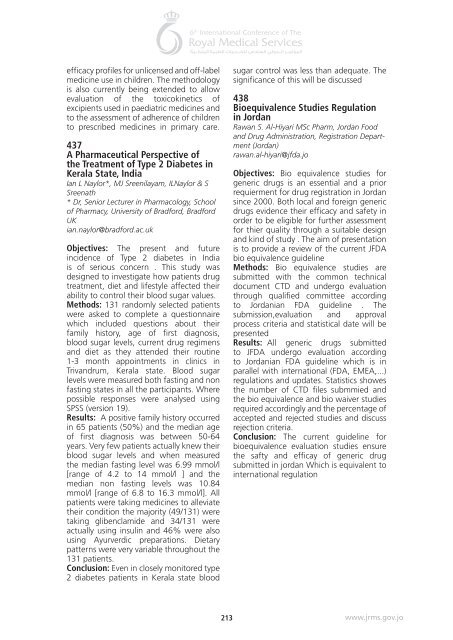Abstract book 6th RMS 16.indd
Abstract book 6th RMS 16.indd
Abstract book 6th RMS 16.indd
You also want an ePaper? Increase the reach of your titles
YUMPU automatically turns print PDFs into web optimized ePapers that Google loves.
efficacy profiles for unlicensed and off-label<br />
medicine use in children. The methodology<br />
is also currently being extended to allow<br />
evaluation of the toxicokinetics of<br />
excipients used in paediatric medicines and<br />
to the assessment of adherence of children<br />
to prescribed medicines in primary care.<br />
437<br />
A Pharmaceutical Perspective of<br />
the Treatment of Type 2 Diabetes in<br />
Kerala State, India<br />
Ian L Naylor*, MJ Sreenilayam, ILNaylor & S<br />
Sreenath<br />
* Dr, Senior Lecturer in Pharmacology, School<br />
of Pharmacy, University of Bradford, Bradford<br />
UK<br />
ian.naylor@bradford.ac.uk<br />
Objectives: The present and future<br />
incidence of Type 2 diabetes in India<br />
is of serious concern . This study was<br />
designed to investigate how patients drug<br />
treatment, diet and lifestyle affected their<br />
ability to control their blood sugar values.<br />
Methods: 131 randomly selected patients<br />
were asked to complete a questionnaire<br />
which included questions about their<br />
family history, age of first diagnosis,<br />
blood sugar levels, current drug regimens<br />
and diet as they attended their routine<br />
1-3 month appointments in clinics in<br />
Trivandrum, Kerala state. Blood sugar<br />
levels were measured both fasting and non<br />
fasting states in all the participants. Where<br />
possible responses were analysed using<br />
SPSS (version 19).<br />
Results: A positive family history occurred<br />
in 65 patients (50%) and the median age<br />
of first diagnosis was between 50-64<br />
years. Very few patients actually knew their<br />
blood sugar levels and when measured<br />
the median fasting level was 6.99 mmol/l<br />
[range of 4.2 to 14 mmol/l ] and the<br />
median non fasting levels was 10.84<br />
mmol/l [range of 6.8 to 16.3 mmol/l]. All<br />
patients were taking medicines to alleviate<br />
their condition the majority (49/131) were<br />
taking glibenclamide and 34/131 were<br />
actually using insulin and 46% were also<br />
using Ayurverdic preparations. Dietary<br />
patterns were very variable throughout the<br />
131 patients.<br />
Conclusion: Even in closely monitored type<br />
2 diabetes patients in Kerala state blood<br />
sugar control was less than adequate. The<br />
significance of this will be discussed<br />
438<br />
Bioequivalence Studies Regulation<br />
in Jordan<br />
Rawan S. Al-Hiyari MSc Pharm, Jordan Food<br />
and Drug Administration, Registration Department<br />
(Jordan)<br />
rawan.al-hiyari@jfda.jo<br />
Objectives: Bio equivalence studies for<br />
generic drugs is an essential and a prior<br />
requierment for drug registration in Jordan<br />
since 2000. Both local and foreign generic<br />
drugs evidence their efficacy and safety in<br />
order to be eligible for further assessment<br />
for thier quality through a suitable design<br />
and kind of study . The aim of presentation<br />
is to provide a review of the current JFDA<br />
bio equivalence guideline<br />
Methods: Bio equivalence studies are<br />
submitted with the common technical<br />
document CTD and undergo evaluation<br />
through qualified committee according<br />
to Jordanian FDA guideline . The<br />
submission,evaluation and approval<br />
process criteria and statistical date will be<br />
presented<br />
Results: All generic drugs submitted<br />
to JFDA undergo evaluation according<br />
to Jordanian FDA guideline which is in<br />
parallel with international (FDA, EMEA,...)<br />
regulations and updates. Statistics showes<br />
the number of CTD files submmied and<br />
the bio equivalence and bio waiver studies<br />
required accordingly and the percentage of<br />
accepted and rejected studies and discuss<br />
rejection criteria.<br />
Conclusion: The current guideline for<br />
bioequivalence evaluation studies ensure<br />
the safty and efficay of generic drug<br />
submitted in jordan Which is equivalent to<br />
international regulation<br />
213 www.jrms.gov.jo

















